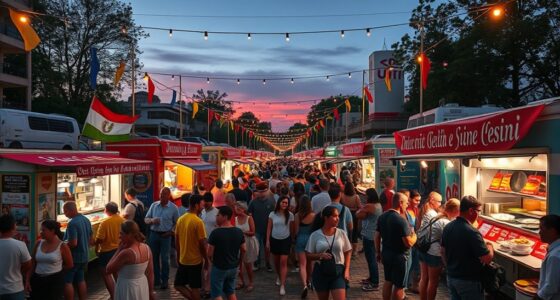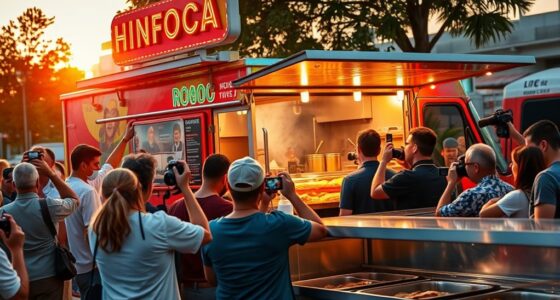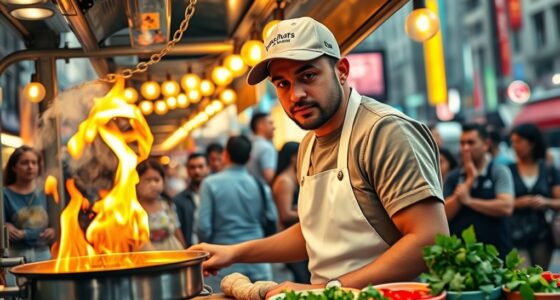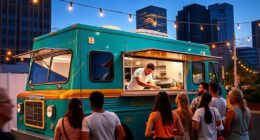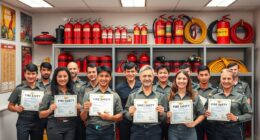To effectively document your food truck build for marketing, plan a clear story from start to finish. Capture photos and videos of key moments, like design sketches, installation, and finishing touches, highlighting craftsmanship and milestones. Share behind-the-scenes content that shows your process, challenges, and solutions. Use social media to build excitement, foster community, and increase engagement. With consistent visuals and storytelling, you’ll create buzz that draws attention to your launch—stick around for more tips on making it stand out.
Key Takeaways
- Capture high-quality photos and videos of each build milestone to showcase progress and craftsmanship.
- Share behind-the-scenes content highlighting design choices, ingredient sourcing, and interior customization.
- Use storytelling techniques to narrate challenges, solutions, and project evolution for authentic engagement.
- Collaborate with local influencers and community figures to expand reach and build credibility.
- Maintain detailed records of content ownership and legal rights to protect your marketing assets.
Planning Your Documentation Strategy
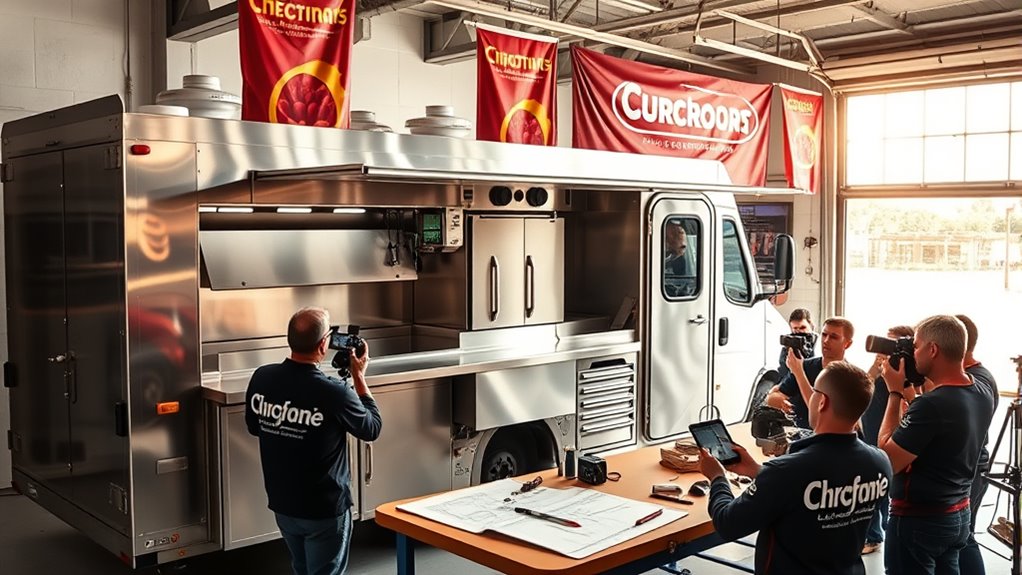
Have you considered how you’ll organize and present your build process from the start? Planning your documentation strategy helps you stay focused and efficient. Think about how you’ll showcase your ingredient sourcing, emphasizing quality and local connections, which can attract customer interest. As you develop your menu, document each step to highlight your creativity and operational choices. Decide whether you’ll use photos, videos, or written updates to tell your story. Structuring your content around key milestones allows for consistent, engaging updates. Incorporating visual storytelling techniques can help you create a compelling narrative for your audience. This approach not only keeps your audience engaged but also creates a thorough record of your journey. Incorporating family dynamics can help you anticipate customer preferences and optimize your menu development. Additionally, integrating website creation essentials ensures your documentation is accessible and professional, effectively communicating your unique food truck concept. Planning your content strategy in advance can also help you make the most of social media platforms to reach a wider audience and generate excitement about your build. Clear planning ensures your documentation aligns with your marketing goals and effectively communicates your unique food truck concept.
Capturing the Design and Concept Development
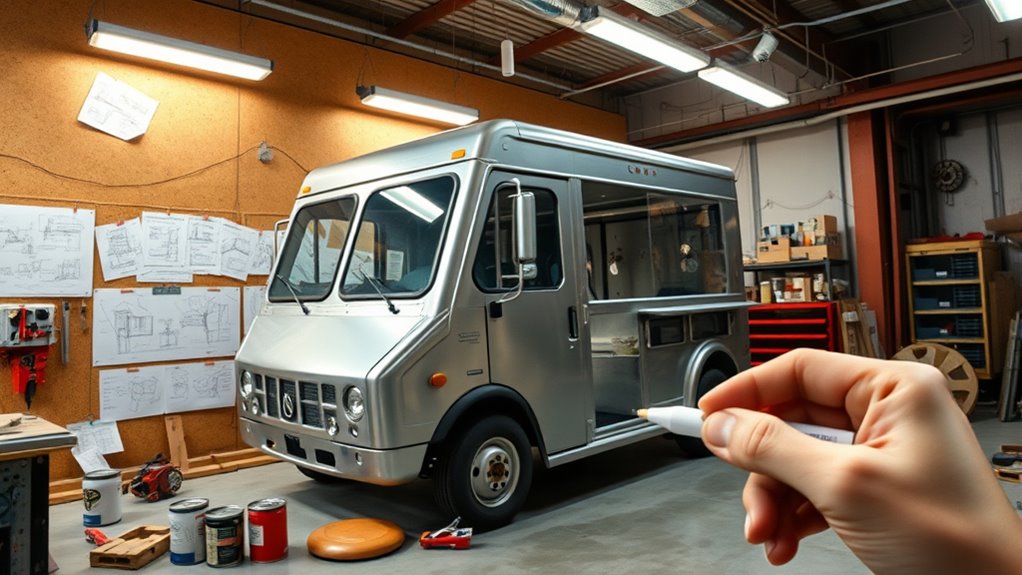
You should start by sketching your vision to clearly visualize your ideas. Choosing the right visual materials helps showcase your concept effectively. These steps guarantee your design development is well-documented and easy to understand. Incorporating natural materials can also make your truck more appealing and engaging to potential customers, especially as consumers increasingly appreciate eco-friendly and sustainable design elements. Additionally, documenting your build process ensures you can track progress and make improvements based on sketches and visual references.
Sketching the Vision
Sketching the vision is a crucial step in transforming your ideas into tangible concepts. Your initial design sketches help visualize how your food truck will look and function, giving you a clear foundation to build upon. Focus on experimenting with your chosen color palette to see how different hues complement each other and reflect your brand identity. These sketches don’t need to be perfect; they’re meant to capture the core elements of your concept. Use them to explore various layouts, signage placements, and visual styles. Documenting your design sketches not only clarifies your vision but also creates valuable marketing content later on. This process allows you to refine your ideas, ensuring your final build aligns with your original concept and appeals to your target audience. Recognizing the importance of color accuracy can motivate you throughout the creative process. Considering branding consistency in your sketches can also help reinforce your food truck’s identity and attract loyal customers. Understanding visual branding helps ensure your design communicates your unique story effectively.
Selecting Visual Materials
Selecting the right visual materials is essential for effectively capturing and conveying your design ideas. Focus on images that highlight key aspects of your food truck’s concept, including food styling and overall aesthetics. Use high-quality photos that showcase your menu items, interior layouts, and branding elements. Incorporate varied angles and lighting to enhance visual storytelling, making your build process engaging for viewers. Consider including behind-the-scenes shots of food styling to demonstrate your attention to detail and creativity. Visual materials should reflect your truck’s personality and appeal to your target audience. Well-chosen images not only document your progress but also build excitement around your brand. Clear, compelling visuals are crucial for marketing and establishing a memorable identity for your food truck. Additionally, visual storytelling techniques can help communicate your brand’s narrative more effectively. Paying attention to vibrational energy in your visuals can also attract positive engagement and resonate more deeply with your audience. Incorporating elements of local culture into your imagery can further strengthen your connection with your community and enhance your brand appeal.
Documenting the Build Phase With Photos and Videos
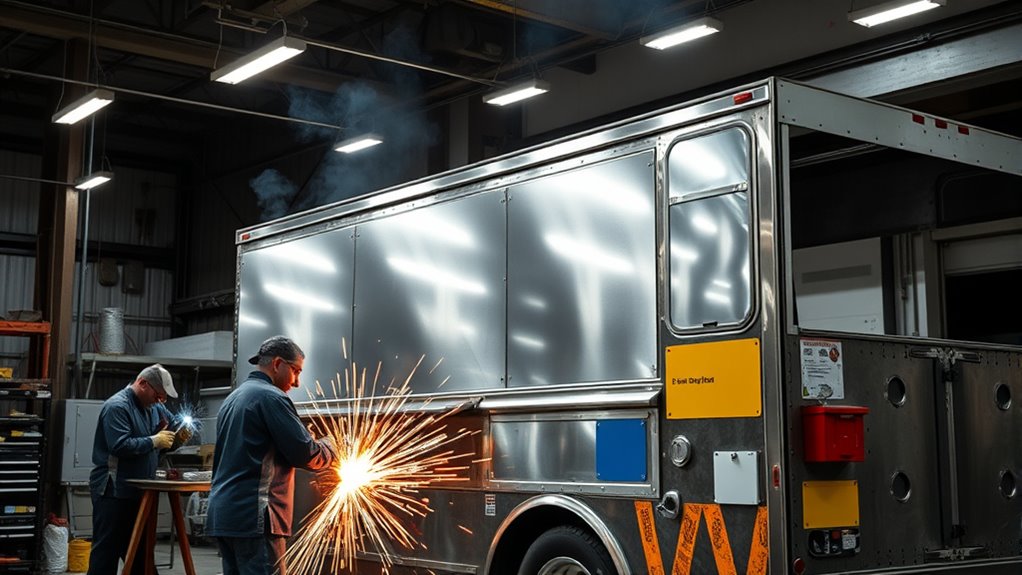
As you document the build phase, make sure to capture key moments that highlight progress and craftsmanship. Showcasing before and after photos helps tell a compelling story of transformation. These visuals will not only serve as a record but also inspire others interested in building their own food trucks. Additionally, maintaining a clear record of your process can be valuable for legal compliance and protecting your content rights. Incorporating content ownership practices ensures your documentation remains your intellectual property. Keeping detailed records can also be beneficial if you need to navigate legal considerations related to your build or business. Being aware of relationship dynamics can help you manage team collaborations effectively during this process. Documenting your work with visual storytelling techniques can further enhance your marketing efforts and engage your audience more effectively.
Capturing Key Moments
Capturing key moments during the build process is essential for documenting your progress and creating a visual record of your project. Focus on moments that highlight the craftsmanship, such as installing appliances or customizing the exterior. These photos and videos can serve as powerful marketing tools later. Consider capturing the details of food styling—like the presentation of your menu items—and the process of adding nutritional info to your branding. These visuals build anticipation and showcase your attention to detail. To make the most of your documentation, prioritize these four ideas:
- Action shots of construction and customization
- Close-ups of food styling details
- Before-and-after comparisons of your truck’s interior and exterior
- Clips of team members working on key tasks
These moments tell your build story clearly and engagingly.
Showcasing Before and After
Showcasing before-and-after photos and videos is one of the most impactful ways to highlight your build progress. These visuals give your audience a clear view of how your food truck evolved, from initial ingredient sourcing to the final setup. Capture the transformation at each stage—show the empty shell, the installation of appliances, and the finishing touches that support menu development. Use time-lapse videos or side-by-side photos to emphasize the progress. Highlight key moments, like installing cooking equipment or custom shelving, to tell your story visually. Not only do these images engage followers, but they also demonstrate your dedication to quality and detail, building anticipation for your menu and brand. This documentation turns your build process into compelling marketing content. Documenting each phase also provides valuable visual content that can be repurposed across your marketing channels to attract customers and investors alike.
Sharing Challenges and Problem-Solving Moments
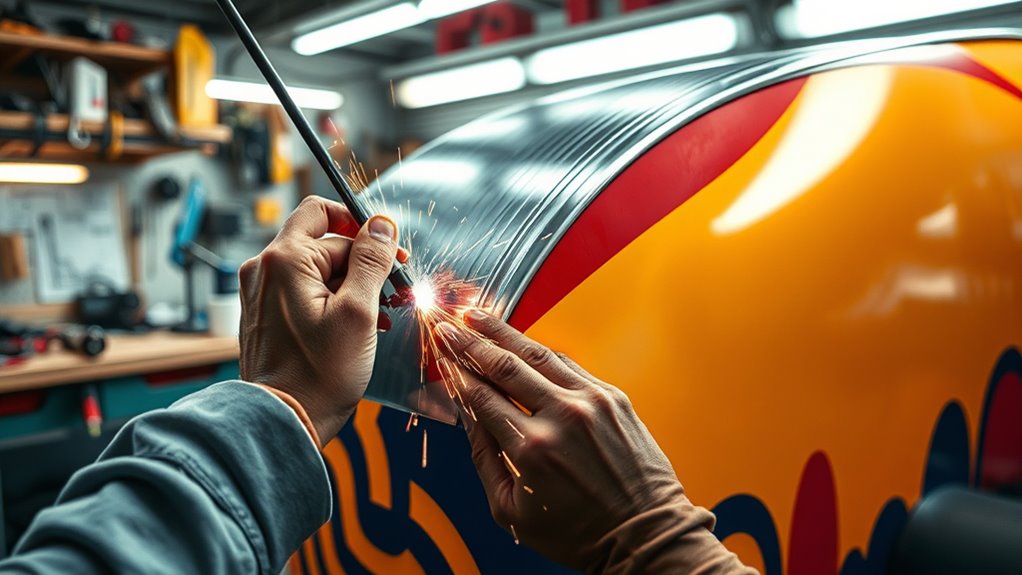
Throughout the build process, you’ll inevitably encounter challenges that test your problem-solving skills and patience. Sharing these moments helps your audience connect with your journey. For example, equipment challenges might delay installations, requiring quick troubleshooting. Design adjustments often become necessary when space constraints or safety codes force changes. Documenting these moments shows your adaptability and dedication. Additionally, understanding legal guidelines related to your project’s safety and compliance can help prevent setbacks. Here are some key ways to share your problem-solving process: 1. Describe the challenge clearly, like fitting equipment into limited space. 2. Explain the steps you took to find solutions. 3. Highlight any unexpected setbacks and how you addressed them. 4. Show before-and-after images to illustrate the adjustments made. Being transparent about setbacks builds authenticity and trust with your audience.
Highlighting Key Milestones in the Build Process
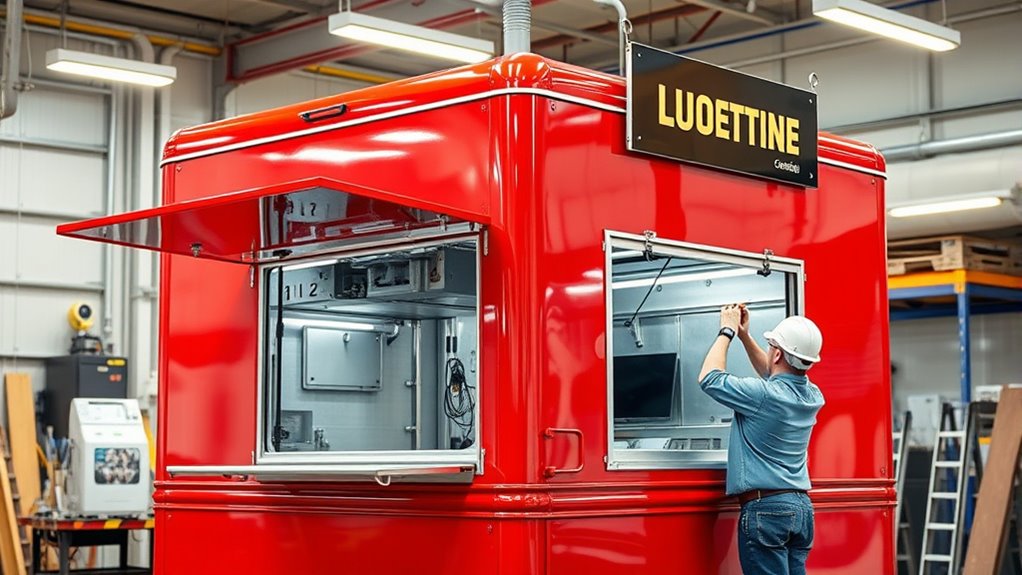
As you review your build process, it’s essential to identify the major construction phases that marked significant progress. Highlighting key milestones, like framing or wiring completions, keeps the project on track. Don’t forget to showcase equipment installation highlights that transformed the truck into a functional kitchen.
Major Construction Phases
The major construction phases of building a food truck mark critical milestones that guarantee a smooth and efficient build process. These phases guarantee your truck’s design and functionality align with your vision. First, you’ll focus on the framing and shell modification, creating a solid foundation. Next, you’ll work on the interior design, including kitchen layouts that maximize space and workflow. Then, you’ll address insulation, electrical wiring, and plumbing to prepare for equipment installation. Finally, you’ll finish with the exterior branding and finishing touches, making your truck visually appealing and ready to operate. These milestones help you track progress and stay organized throughout the build, ensuring your food truck is both functional and attractive from start to finish.
- Framing & Shell Modification
- Interior Design & Kitchen Layouts
- Insulation, Electrical, & Plumbing
- Exterior Finishing & Branding
Equipment Installation Highlights
Installing equipment marks a pivotal milestone in your food truck build, transforming the interior from a shell into a fully functional kitchen. This step involves key appliance upgrades, such as installing ovens, refrigerators, and cooking stations, which are essential for your menu. As you progress, scheduling safety inspections guarantees that all equipment complies with health and safety standards, preventing future issues. Documenting these milestones highlights your commitment to quality and safety, which appeals to customers and inspectors alike. Proper installation not only improves workflow but also boosts efficiency. Keep track of each upgrade and inspection, sharing these moments on social media to build excitement and credibility. This phase is critical in turning your vision into reality and showcasing your professional approach.
Engaging Your Audience With Behind-The-Scenes Content

Sharing behind-the-scenes content can substantially boost your audience’s engagement by giving them an authentic look at your build process. Show them how you plan food styling, select ingredients, or set up nutrition facts labels for your menu. This transparency builds trust and excitement around your food truck. To keep your content engaging, consider these ideas:
Sharing behind-the-scenes moments boosts engagement and builds trust with authentic glimpses into your build process.
- Capture the food styling process for your signature dishes
- Share quick clips of assembling and decorating your menu items
- Show the creation of nutrition facts labels and their importance
- Document the daily progress of your build, emphasizing authentic moments
This approach keeps your audience connected to your journey, making them more likely to support and share your story. Authentic behind-the-scenes content creates a compelling narrative your followers will love.
Utilizing Social Media Platforms for Maximum Reach
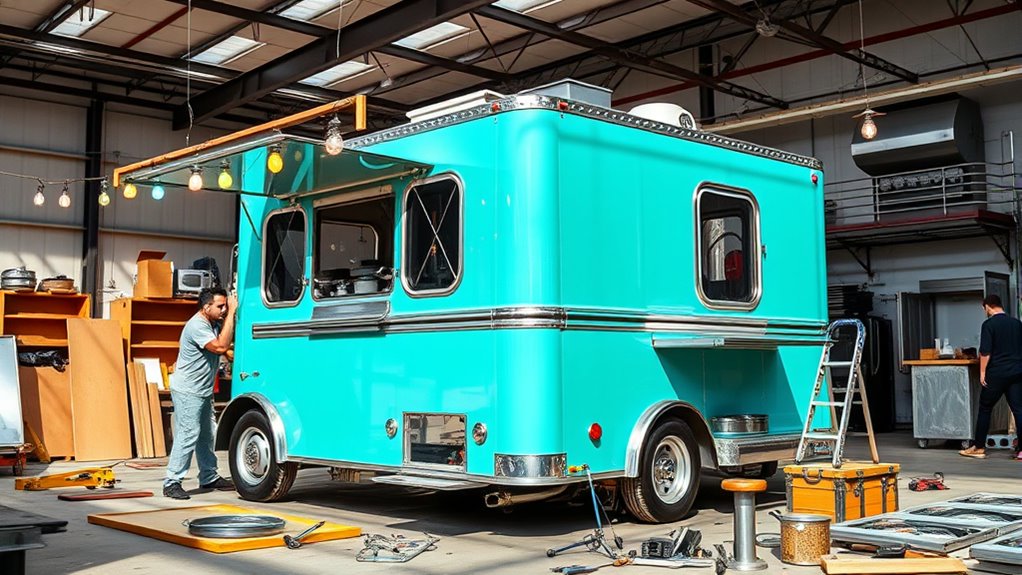
To maximize your reach, you need to strategically leverage social media platforms that your target audience uses most. Focus on sharing eye-catching food photography that highlights your build process and final dishes. Engage influencers in your niche for outreach—these partnerships can expand your visibility quickly. Use platform-specific strategies: Instagram for visuals, TikTok for behind-the-scenes clips, and Facebook for community building.
| Platform | Best Practice |
|---|---|
| Post high-quality food photos and stories | |
| TikTok | Share quick build updates and recipes |
| Create events and engage with local communities |
Creating a Narrative That Reflects Your Brand Identity
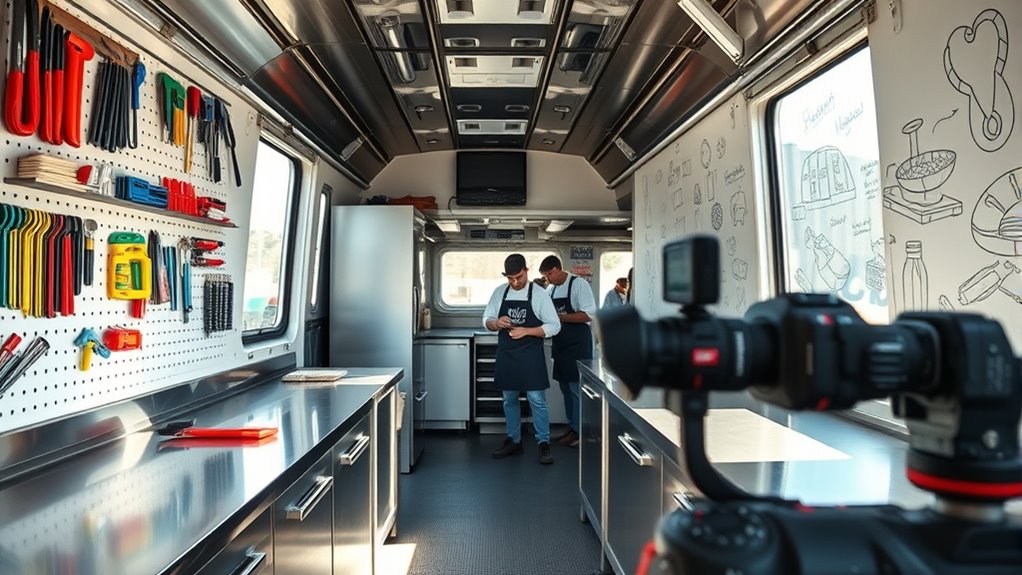
Building a strong narrative that reflects your brand identity helps you stand out amid the busy food truck scene. Effective brand storytelling connects your story, values, and mission with your audience, creating a memorable experience. To craft this narrative, focus on key elements that showcase your unique identity and reinforce your visual branding.
Here are four ways to create a compelling story:
- Share your origin story and what inspired your food truck.
- Highlight your core values and what sets you apart.
- Use visual branding elements—logos, colors, and design—to support your story.
- Incorporate authentic visuals and messaging across all platforms.
Incorporating Customer and Community Involvement
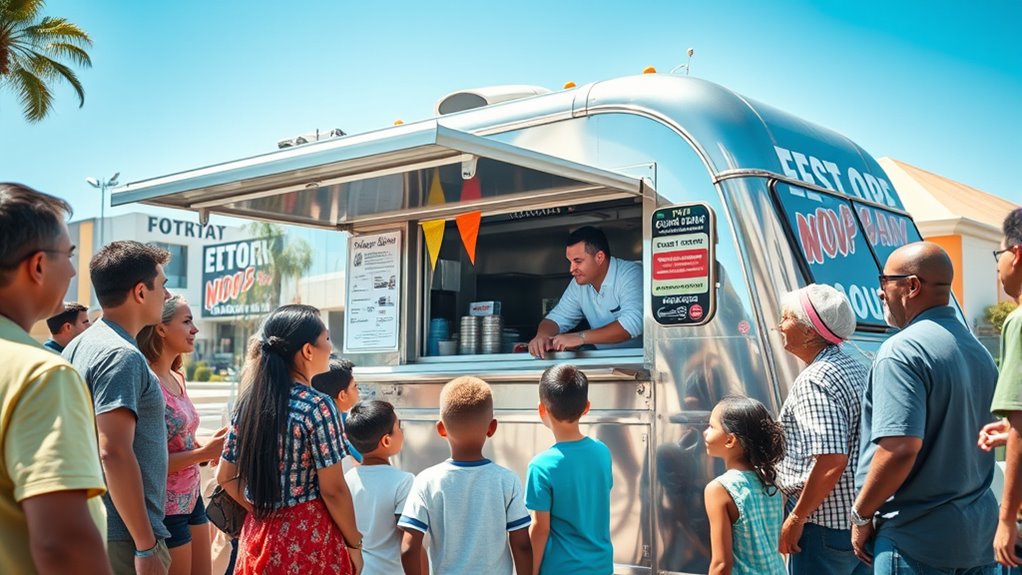
Involving your customers and community members actively strengthens your food truck’s presence and fosters loyalty. Gathering customer feedback during the build process shows that you value their opinions, helping shape your offerings and design to better meet their needs. Share updates on social media about community events you plan to participate in or host, inviting locals to get involved early. Highlighting your engagement demonstrates your commitment to the community, making people feel connected to your brand. You can also incorporate stories from community members or showcase their input in your build documentation. This transparency builds trust and encourages support. Ultimately, involving your audience creates a sense of ownership, turning customers into advocates who’ll enthusiastically share your journey and help spread the word.
Using Your Build Journey to Generate Buzz for Launch

As you progress through your build, sharing your journey creates excitement and anticipation for your upcoming launch. It helps reinforce your branding strategy and connects with your audience. To generate buzz, consider these ideas:
- Document behind-the-scenes moments on social media to showcase your progress.
- Collaborate with influencers in the food or local community to expand your reach.
- Use engaging storytelling to highlight your brand values and build a loyal following.
- Tease upcoming milestones or special features to keep followers enthusiastic for the launch.
Frequently Asked Questions
How Can I Measure the Effectiveness of My Documentation for Marketing?
To measure how effective your documentation is for marketing, focus on engagement metrics like views, shares, and comments to see how your audience interacts. Additionally, conduct audience surveys to gather direct feedback on whether your content resonates and influences their perceptions. By analyzing these metrics and survey responses, you’ll gain valuable insights into what works, helping you refine your documentation to better connect with your target audience.
What Legal Considerations Should I Keep in Mind When Sharing Build Content?
When sharing build content, you should consider legal aspects like protecting your intellectual property and respecting privacy concerns. Avoid sharing proprietary designs or unique features without permission, and be cautious about revealing sensitive information that could infringe on trademarks or patents. verify you have rights to any images or content you post, and get consent if you include people’s images or personal details to prevent privacy issues.
How Do I Ensure My Documentation Appeals to Diverse Audience Segments?
To make sure your documentation appeals to diverse audience segments, focus on visual storytelling that highlights different cultures and experiences. Use inclusive images, language, and narratives that resonate with various communities. Show diverse team members, cultural inspirations, and inclusive practices. This approach not only fosters cultural inclusivity but also makes your content more engaging and relatable, helping you connect authentically with a broad audience.
What Budget-Friendly Tools Are Best for Professional-Quality Documentation?
Imagine capturing your story without breaking the bank. You can achieve professional-quality documentation using affordable photography tools like smartphone lenses and natural lighting. Pair this with DIY video editing apps such as InShot or DaVinci Resolve, which are user-friendly and budget-friendly. These tools help you create compelling visuals that showcase your food truck journey, making your marketing authentic and engaging without costly equipment.
How Can I Incorporate Customer Feedback Into My Build Documentation?
You can incorporate customer feedback into your build documentation by conducting a customer survey to gather insights on what they want. Use feedback integration to reflect their preferences and concerns, making updates to your process and documenting these changes clearly. Share this feedback-driven evolution in your marketing materials, showing how customer input shapes your food truck, which builds trust and demonstrates your commitment to meeting their needs.
Conclusion
As you share your food truck journey, remember that every step echoes the spirit of a pioneer charting new territory—like Lewis and Clark forging ahead. Your authentic storytelling transforms your build into a fascinating adventure, inspiring others and building anticipation for launch. Keep the momentum going, and let your passion shine through each post. In doing so, you’ll turn your behind-the-scenes efforts into a shining beacon that draws customers and community alike, ready to set out on this flavorful voyage with you.


